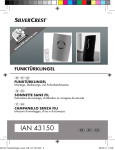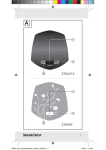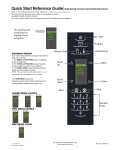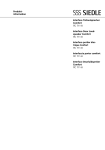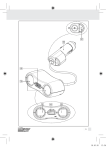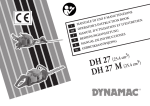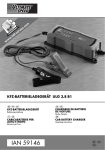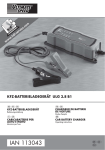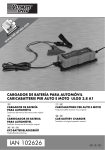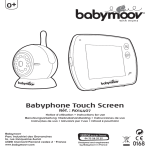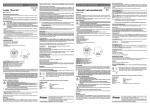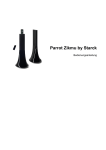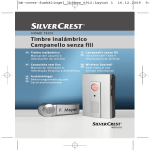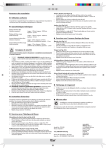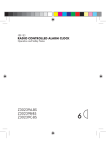Download Z30914 - Lidl Service Website
Transcript
Timbre inalámbrico I nstrucciones de utilización y de seguridad Campanello senza fili I ndicazioni per l’uso e per la sicurezza Campainha sem fios I nstruções de utilização e de segurança Wireless Doorbell O peration and Safety Notes F unktürklingel B edienungs- und Sicherheitshinweise Z30914 5 29.06.11 18:00 ES IT / MT PT GB / MT DE / AT / CH Instrucciones de utilización y de seguridad Indicazioni per l’uso e per la sicurezza Instruções de utilização e de segurança Operation and Safety Notes Bedienungs- und Sicherheitshinweise Página Pagina Página Page Seite 7 20 34 47 60 29.06.11 18:00 29.06.11 18:00 Necesita Vi servono Necessita de ø 6 mm You need Sie benötigen: A 1 2 VOL 3 4 5 6 7 3 30.06.11 15:48 B 10 AA 1.5V 9 AA 1.5V 8 4 30.06.11 15:48 C 11 12 13 D 14 15 5 30.06.11 15:48 E 16 VOL F 17 17 16 18 6 30.06.11 15:48 Índice Introducción Uso conforme a su finalidad............................................................. Página Datos técnicos .................................................................................... Página Volumen de suministro ....................................................................... Página Descripción de piezas ....................................................................... Página 8 8 9 9 Seguridad ...................................................................................... Página 10 Indicaciones generales de seguridad ............................................. Página 11 Indicaciones de seguridad relativas a las pilas.............................. Página 12 Montaje............................................................................................ Página 13 Puesta en marcha Colocación / cambio de las pilas..................................................... Página 14 Manejo Sincronización transmisor / receptor................................................ Página Ajustar el tipo de señal...................................................................... Página Ajustar el volumen.............................................................................. Página Selección de tono de alarma .......................................................... Página Eliminar errores .................................................................................. Página 15 15 16 16 16 Limpieza y mantenimiento ............................................ Página 17 Eliminación.................................................................................... Página 18 Informaciones Declaración de conformidad ............................................................. Página 19 ES 7 30.06.11 15:48 Introducción Timbre inalámbrico Introducción Conserve adecuadamente estas instrucciones. Adjunte igualmente toda la documentación en caso de entregar el artefacto a un tercero. Uso conforme a su finalidad Este producto está destinado para la transmisión inalámbrica de la señal del timbre de puerta. El producto no ha sido concebido para el uso comercial. Datos técnicos Alcance: 100 m (espacios abiertos) Frecuencia de transmisión: 433 MHz Tipos de pila: Receptor: 2 x 1,5 V (tipo AA / LR6), Transmisor: 1 x 3 V (tipo CR2032) Receptor: Volumen de tono de alarma (con nivel máximo de volumen): mín. 73 dB (a una distancia del aparato de 1m) 8 ES 30.06.11 15:48 Introducción Transmisor: Tipo de protección: IPX4 Volumen de suministro 1 emisor 1 receptor 1 pie de apoyo (para el receptor) 2 pilas 1,5 V ,tipo AA (receptor) 1 pila 3 V , tipo CR2032 (transmisor) 3 tornillos (para el emisor y para el montaje en la pared del transmisor) 3 tacos 5 placas para nombre intercambiables (para el timbre de la puerta) 1 tapa para la placa para nombre 1 manual de instrucciones Descripción de piezas Receptor (fig. A / B): 1 Indicador de señal 2 Tecla de sincronización 3 Tecla de ajuste de volumen 4 Tecla de selección de tono de timbre ES 9 30.06.11 15:48 Introducción / Seguridad 5 Tecla de selección del tipo de señal (señal óptica, acústica, 6 7 8 9 10 óptica y acústica) Altavoz Soporte de pie Colgador Tapa del compartimento para pilas Compartimento para pilas Transmisor (fig. C / D): 11 Indicador de señal 12 Placa para nombre 13 Tecla de timbre 14 Compartimento para pilas 15 Soporte (para montaje en la pared) Montaje (fig. E / F ): 16 Tornillo 17 Taco 18 Tornillo (para el transmisor) Seguridad ¡ADVERTENCIA! Lea todas las indicaciones de seguridad y las instrucciones. El incumplimiento de las advertencias e indicaciones de seguridad puede provocar descargas eléctricas, incendios y / o lesiones graves. 10 ES 30.06.11 15:48 Seguridad ¡CONSERVE TODAS LAS INDICACIONES DE SEGURIDAD Y ADVERTENCIAS POR SI NECESITA CONSULTARLAS MÁS ADELANTE! Indicaciones generales de seguridad ¡ADVERTENCIA! ¡PELIGRO DE MUERTE Y RIESGO DE ACCIDENTE PARA BEBÉS Y NIÑOS! Nunca deje a los niños sin vigilancia con el material de embalaje. Existe peligro de asfixia por el material de embalaje. Los niños suelen subestimar los peligros. Mantenga siempre a los niños alejados del producto. No es un juguete. Los niños o las personas que carezcan de los conocimientos o la experiencia necesarios para manipular el aparato, o aquellas cuyas capacidades físicas, sensoriales o psicológicas estén limitadas, no deben utilizar el aparato sin la supervisión o la dirección de una persona responsable por su seguridad. Debe mantenerse a los niños vigilados para que no jueguen con el aparato. Revise que todas las piezas estén íntegras. En caso del montaje de piezas dañadas existe peligro de lesiones. Revise que todas las piezas estén montadas adecuadamente. En caso del montaje inadecuado existe peligro de lesiones. Mantenga el aparato alejado del fuego y de las fuentes de calor (p. ej., velas). ES 11 30.06.11 15:48 Seguridad Indicaciones de seguridad relativas a las pilas ¡ADVERTENCIA! ¡PELIGRO DE MUERTE! Las pilas pueden ingerirse, lo que puede suponer un peligro mortal. En caso de ingestión de pilas, solicite ayuda médica de inmediato. ¡PELIGRO DE EXPLOSIÓN! No recargue nunca pilas desechables, no las ponga en cortocircuito ni las abra. Las pilas pueden sobrecalentarse, incendiarse o estallar. No arroje las pilas ni al fuego ni al agua. Las pilas podrían explotar. Retire en seguida las pilas agotadas del aparato. Existe un alto riesgo de sulfatación. Cambie siempre todas las pilas al mismo tiempo y utilice únicamente pilas del mismo tipo. No combine diferentes tipos de pilas ni pilas nuevas con usadas. Las pilas no deben eliminarse junto con los residuos domésticos. Elimine las pilas usadas de una forma respetuosa con el medio ambiente. ¡Todos los consumidores están obligados legalmente a desechar las pilas debidamente! Mantenga las pilas alejadas de los niños, no las eche al fuego, no las ponga en cortocircuito ni las desarme. El no cumplimiento de las indicaciones puede ocasionar que la pila se descargue más allá de la tensión final. Esto ocasionará riesgo de derrame. ¡Si la pila se hubiese derramado en su artefacto, retírela inmediatamente a fin de evitar daños en el artefacto! 12 ES 30.06.11 15:48 Seguridad / Montaje Evite el contacto con la piel, ojos y mucosas. ¡En caso de contacto con el ácido de la pila, enjuague la zona afectada con abundante agua y / o consulte a un médico! No emplee pilas recargables. Nunca ponga en cortocircuito a los polos de conexión. Nunca use al mismo tiempo pilas usadas y nuevas. Extraiga la pila del aparato cuando no lo haya utilizado durante un período de tiempo prolongado. Al introducir las pilas, tenga en cuenta la polaridad correcta. Montaje Nota: para montar el timbre, necesita un destornillador y una taladradora. Nota: para el montaje, utilice únicamente los tornillos y los tacos suministrados. Colocación del receptor (véase fig. E) Colocación del transmisor (véase fig. F) ES 13 30.06.11 15:48 Puesta en marcha Puesta en marcha Colocación / cambio de las pilas Antes de poner en marcha el aparato, introduzca las pilas para el suministro de energía. ¡ATENCIÓN! Utilice exclusivamente el tipo de pila indicado. En caso contrario, el producto podría dañarse. Receptor: Retire la tapa del compartimento para pilas 9 que se encuentra en la parte trasera. En caso necesario, retire las pilas gastadas. Introduzca 2 pilas (1,5 V , tipo AA). Nota: preste atención a la polaridad correcta. Ésta está indicada en el compartimento 10 para pilas. Cierre el compartimento para pilas 10 . Transmisor: Reitre el soporte 15 situado en la parte posterior del transmisor. Abra el compartimento para pilas 14 girando la tapa del mismo en sentido contrario al de las agujas del reloj. Introduzca una pila (3 V , tipo CR 2032). La parte marcada con “+” debe mirar hacia arriba. Coloque la tapa sobre el compartimento para pilas 14 y fíjela girándola en el sentido de las agujas del reloj. Vuelva a fijar el soporte del 15 transmisor en la parte trasera del aparato. 14 ES 30.06.11 15:48 Manejo Manejo Sincronización transmisor / receptor Para sincronizar el transmisor y el receptor, siga los siguientes pasos: Pulse la tecla de sincronización 2 . Pulse la tecla de timbre 13 , el indicador de señal 1 parpadea en rojo. Entonces, suena el tono de alarma programado y el indicador de señal 1 se apaga. Si el aparato receptor no reacciona tal y como se ha descrito, apriete la tecla de sincronización 2 de nuevo. La función de sincronización se termina. Reanudar el proceso de sincronización. La transmisión de la señal entre el emisor y el transmisor se muestra mediante un breve parpadeo del indicador de señal 11 . Ajustar el tipo de señal El receptor puede mostrar una señal de puerta recibida bien ópticamente, bien acústicamente o bien de las dos maneras. Sirviéndose de la tecla de selección del tipo de señal 5 , seleccione si desea que la señal se muestre ópticamente, acústicamente o de las dos maneras. ES 15 30.06.11 15:48 Manejo Ajustar el volumen Pulse la tecla de volumen 3 hasta alcanzar el volumen deseado. En total hay 5 niveles de volumen posibles: muy alto, alto, intermedio, bajo, muy bajo. Selección de tono de alarma Nota: el timbre dispone de más de 36 tonos de alarma diferentes. Pulse la tecla de selección de tono de timbre 4 . Suena el primer tono de alarma. Pulse otra vez la tecla de selección de tono de timbre 4 para pasar al siguiente tono de alarma. Repita el proceso hasta que alcance el tono de alarma deseado. Automáticamente, se almacena el último tono de alarma seleccionado. Eliminar errores Es muy probable que el artefacto no funcione correctamente luego de estar expuesto a condiciones climáticas extraordinarias (p. ej. un fuerte campo electromagnético). En ese caso retire las pilas de ambos artefactos por aprox. 2 minutos. Proceda posteriormente como se describe en “Sincronización transmisor / receptor”. 16 ES 30.06.11 15:48 Manejo / Limpieza y mantenimiento Las descargas electrostáticas pueden ocasionar fallas en el funcionamiento. En caso de tales fallas retire la pila y colóquela nuevamente. Proceda posteriormente como se describe en “Sincronización transmisor / receptor”. Limpieza y mantenimiento No utilice en ningún caso líquidos o productos de limpieza ya que éstos dañarían el aparato. Limpie el aparato sólo por fuera con un paño suave y seco. ES 17 30.06.11 15:48 Eliminación Eliminación El embalaje está compuesto por materiales no contaminantes que pueden ser eliminados en el centro de reciclaje local. Puede averiguar las posibilidades de eliminación del producto estropeado en la administración de su comunidad o ciudad. No elimine el producto estropeado con los desechos domésticos, sino hágalo de manera correcta. Proteja así el medio ambiente. Se puede informar en la oficina competente de su administración sobre los puestos de recogida y sus horarios de atención al público. Las baterías defectuosas o agotadas deben reciclarse según la directiva 2006 / 66 / EC. Deseche la batería y / o el aparato a través de los puntos de recogida disponibles. Pb Hg ¡Daño medioambiental debido a un reciclaje incorrecto de las pilas! Las pilas no deben eliminarse junto a los residuos domésticos. Las pilas pueden contener metales pesados tóxicos que debe tratarse conforme a la normativa aplicable a los residuos especiales. Los símbolo químicos de los metales pesados son: Cd = Cadmio, Hg = Mercurio, Pb = Plomo. Las pilas deben reciclarse en el punto de recolección específico para ello. 18 ES 30.06.11 15:48 Informaciones Informaciones Declaración de conformidad Nosotros Milomex Ltd., c / o Milomex Services, Hilltop Cottage, Barton Road, Pulloxhill, Bedfordshire, MK45 5HP, UK, declaramos bajo responsabilidad propia, que el producto: Timbre inalámbrico, N.º de modelo: Z30914, Versión: , referido en esta declaración, cumple con las normas / documentos normativos de la directiva 1999 / 5 / EC. Si es necesario puede descargar estos documentos de www.milomex.com. EMC ES 19 30.06.11 15:48 Indice Introduzione Scopo d’impiego ...............................................................................Pagina Dati tecnici ..........................................................................................Pagina Dotazione ...........................................................................................Pagina Quadro sinottico dei componenti ....................................................Pagina 21 21 22 22 Sicurezza ........................................................................................Pagina 23 Avvisi di sicurezza generali ..............................................................Pagina 24 Indicazioni di sicurezza relative alle batterie .................................Pagina 25 Montaggio ....................................................................................Pagina 26 Avvio Inserimento / sostituzione delle batterie ..........................................Pagina 27 Funzionamento Sincronizzazione dell’emettitore / ricevitore ...................................Pagina Impostazione del tipo di segnale .....................................................Pagina Impostazione del volume ..................................................................Pagina Scelta del segnale acustico ..............................................................Pagina Eliminazione di errori ........................................................................Pagina 28 28 29 29 29 Pulizia e manutenzione ....................................................Pagina 30 Smaltimento ................................................................................Pagina 31 Informazioni Dichiarazione di conformità .............................................................Pagina 32 20 IT/MT 30.06.11 15:48 Introduzione Campanello senza fili Introduzione Conservate quest’istruzione per bene. Consegnate altresì tutti i documenti quando date questo prodotto a terzi. Scopo d’impiego Questo prodotto è stato realizzato per il trasferimento senza fili del segnale del campanello. Questo prodotto non è stato realizzato per l’uso professionale. Dati tecnici Portata: Frequenza di trasmissione: Tipi di batteria: Ricevitore: 100 m (zona aperta) 433 MHz Ricevitore: 2 x 1,5 V (Tipo AA / LR6), Emettitore: 1 x 3 V (Tipo CR2032), Volume del segnale acustico (in caso di regolazione del volume al livello massimo): min. 73 dB (a una distanza dall’apparecchio di 1 m) IT/MT 21 30.06.11 15:48 Introduzione Emettitore: Tipo di protezione: IPX4 Dotazione 1 emettitore 1 ricevitore 1 base (per il ricevitore) 2 batterie 1,5 V , Tipo AA (ricevitore) 1 batteria 3 V Tipo CR2032 (emettitore) 3 viti (per emettitore e per il montaggio a parete del ricevitore) 3 tasselli 5 targhette sostituibili (per il campanello per porta) 1 copertura per targhetta di campanello 1 libretto di istruzioni d’uso Quadro sinottico dei componenti Ricevitore (vedi figg. A / B) 1 Indicatore del segnale 2 Tasto di sincronizzazione 3 Tasto del volume 4 Tasto di selezione della suoneria 22 IT/MT 30.06.11 15:48 Introduzione / Sicurezza 5 Tasto di selezione del tipo di segnale (segnale ottico, acustico, 6 7 8 9 10 ottico e acustico) Altoparlante Base Dispositivo di sospensione Coperchio del vano portabatterie Vano portabatterie Emettitore (vedi figg. C / D) 11 Indicatore del segnale 12 Targhetta 13 Tasto della suoneria 14 Vano portabatterie 15 Supporto (per montaggio a parete) Montaggio (vedi figg. E / F): 16 Vite 17 Tassello 18 Vite (per l’emettitore) Sicurezza Leggere tutte le indicazioni di sicurezza e le istruzioni riportate. Il mancato rispetto delle indicazioni di sicurezza e delle istruzioni d’uso può provocare incendi e / o gravi lesioni. IT/MT 23 30.06.11 15:48 Sicurezza CONSERVI TUTTE LE ISTRUZIONI E GLI AVVISI DI SICUREZZA PER CONSULTARLI IN FUTURO! Avvisi di sicurezza generali PERICOLO DI VITA E D’INFORTUNI PER BAMBINI ED INFANTI! Non lasciate mai i bambini inosservati con il materiale d’imballaggio, poichè persiste pericolo di soffocamento. I bambini spesso sottovalutano i pericoli. Tenete sempre i bambini lontani dalla portata del prodotto. Non è un giocattolo. Senza la sorveglianza o la guida di una persona responsabile, questo apparecchio non deve essere utilizzato da bambini né da persone non in possesso della conoscenza e dell’esperienza necessarie per maneggiarlo, o le cui capacità corporali, sensoriali o intellettuali fossero limitate. I bambini devono essere sorvegliati affinché non giochino con l’apparecchio. Controllate che tutti i pezzi siano impeccabili. Il montaggio di pezzi danneggiati può presentare un pericolo di lesioni. Controllate che tutti i pezzi siano montati in modo giusto. Un montaggio scorretto può presentare dei pericoli di lesione. Tenere l’apparecchio lontano da fiamme libere e da fonti di calore (ad esempio, da candele accese). 24 IT/MT 30.06.11 15:48 Sicurezza Indicazioni di sicurezza relative alle batterie PERICOLO DI MORTE! Le batterie potrebbero essere inghiottite, circostanza che può rappresentare un pericolo di morte. In caso di ingerimento di una batteria chiedere subito l’intervento di un medico. PERICOLO DI ESPLOSIONE! Non ricaricare mai batterie non ricaricabili, non cortocircuitarle né aprirle. Ciò potrebbe causarne il surriscaldamento, l’incendio o l’esplosione. Non gettare mai le batterie nel fuoco o in acqua. Le batterie potrebbero infatti esplodere. Rimuovere subito dall’apparecchio le batterie esaurite. Sussiste un notevole pericolo di perdita! Sostituire sempre tutte le batterie contemporaneamente e inserire solamente batterie nuove dello stesso tipo. Non utilizzare tipi diversi di batteria oppure batterie usate e nuove contemporaneamente. Le batterie non devono essere gettate nella spazzatura domestica! Smaltire batterie usate in modo non dannoso per l’ambiente. Ogni consumatore è obbligato dalla legge di smaltire regolarmente le pile! Tenete le pile lontano dalla portata dei bambini, non gettatele nel fuoco, non sottoponetelo sotto corto circuito e non smontatele. IT/MT 25 30.06.11 15:48 Sicurezza / Montaggio In caso di inosservanza delle avvertenze le pile si possono scaricare tramite la loro tensione finale. Persiste poi il pericolo d’uscita dell’acido dalle pile. In caso l’acido delle pile sia fuoruscito mentre le pile si trovavano dentro l’apparecchio, toglietele subito per evitare danni al prodotto! Evitate il contatto con la pelle, gli occhi e mucosa. In caso di contatto con l’acido delle pile, lavate subito la parte colpita con molta acqua e / o consultate un medico! Non utilizzate pile che si possano ricaricare. Non sottoponete i poli d’attacco sotto corto circuito. Non impiegate mai insieme pile vecchie con pile nuove. Rimuovere le batterie dall’apparecchio qualora questo non venisse utilizzato per lungo tempo. Inserendo le batterie fare attenzione a che la polarità sia corretta. Montaggio Nota: Per il montaggio del campanello per porta, è necessario utilizzare un cacciavite e un trapano. Nota: Per il montaggio utilizzare solamente le viti e i tasselli in dotazione. Montaggio del ricevitore (vedi fig. E) Montaggio dell’emettitore (vedi fig. F) 26 IT/MT 30.06.11 15:48 Avvio Avvio Inserimento / sostituzione delle batterie Prima di avviare l’apparecchio inserire le batterie per l’alimentazione di energia. ATTENZIONE! Utilizzare solamente il tipo di batteria indicato. In caso contrario vi è il pericolo di danneggiamento del prodotto. Ricevitore: Rimuovere il coperchio del vano portabatterie 9 posto sul lato posteriore. Se necessario, rimuovere le batterie scariche. Inserire due batterie (1,5 V , di tipo AA). Nota: Facendo questo, tenere conto della polarità corretta. Questa viene mostrata nel vano portabatterie 10 . Chiudere il vano portabatterie 10 . Emettitore: Rimuovere il supporto 15 posto sul retro dell’emettitore. Aprire il vano portabatterie 14 , ruotando il coperchio del vano portabatterie in senso antiorario. Inserire una batteria (3 V , di tipo CR 2032). Il punto contrassegnato con “+” deve essere rivolto verso l’alto. Porre il coperchio del vano portabatterie sul vano portabatterie 14 medesimo e stringerlo in senso orario. Fissare nuovamente il supporto 15 dell’emettitore sul lato posteriore dell’apparecchio. IT/MT 27 30.06.11 15:48 Funzionamento Funzionamento Sincronizzazione dell’emettitore / ricevitore Sincronizzare l’emettitore e il ricevitore nel modo seguente: Premere il tasto di sincronizzazione 2 . Premere il tasto del campanello 13 , la visualizzazione del segnale 1 lampeggia di colore rosso. La tonalità di segnale programmata risuona e l‘indicatore del segnale 1 si spegne. Se il ricevitore non reagisce come descritto, premere nuovamente il tasto di sincronizzazione 2 . La funzione di sincronizzazione viene terminata. Ripetere la procedura di sincronizzazione. L’emettitore visualizza la trasmissione del segnale al ricevitore con un breve lampeggio dell’indicatore di segnale 11 . Impostazione del tipo di segnale Il ricevitore può visualizzare il segnale ricevuto dalla porta otticamente o acusticamente, oppure sia otticamente sia acusticamente. Operando sul tasto di selezione del tipo di segnale 5 , scegliere se il segnale debba essere visualizzato otticamente o acusticamente, oppure sia otticamente che acusticamente. 28 IT/MT 30.06.11 15:48 Funzionamento Impostazione del volume Premere il tasto del volume 3 , fino a quando il volume desiderato è stato raggiunto. Vi sono complessivamente 5 possibilità di regolazione del volume: altissimo, alto, medio, basso, molto basso. Scelta del segnale acustico Nota: Questo campanello per porta dispone di 36 segnali acustici diversi. Premere il tasto di selezione della suoneria 4 . Il primo segnale acustico risuona. Per accedere al segnale acustico successivo, premere nuovamente il tasto di selezione dei segnale acustico 4 . Ripetere la procedura fino a quando si è giunti al segnale acustico scelto. L’ultimo segnale acustico scelto viene memorizzato automaticamente. Eliminazione di errori Con l’influenza di condizioni ambientali straordinarie (per es. un forte campo elettromagnetico), il prodotto probabilmente non potrà più funzionare in modo impeccabile. Togliete in questo caso per ca. 2 minuti le pile di tutti e due gli apparecchi. Procedete infine come descritto sotto “Sincronizzazione dell’emettitore / ricevitore“. IT/MT 29 30.06.11 15:48 Funzionamento / Pulizia e manutenzione Scariche elettrostatiche possono portare a disturbi nella funzione. Togliete in caso di tali disturbi per breve tempo le pile e inseritele nuovamente. Procedete infine come descritto sotto “Sincronizzazione dell’emettitore / ricevitore”. Pulizia e manutenzione Non utilizzate per nessuna ragione liquidi o detergenti che danneggerebbero l‘apparecchio. Pulite esclusivamente l‘esterno dell‘apparecchio con un panno morbido ed asciutto. 30 IT/MT 30.06.11 15:48 Smaltimento Smaltimento La confezione è prodotta in materiale riciclabile e biodegradabile, smaltibile nei luoghi di raccolta differenziati. Potete informarvi sulle possibilità di smaltimento del prodotto consumato dall‘amministrazione comunale e cittadina. Per la salvaguardia della tutela ambientale, quando il vostro prodotto non funziona più, non gettatelo nei rifiuti domestici bensì nei luoghi adatti di raccolta. Potete informarvi sui luoghi di raccolta e i loro orari di apertura dall‘amministrazione competente. Gli accumulatori difettosi o esausti devono essere riciclati in base alla direttiva 2006 / 66 / EC. Riconsegnare gli accumulatori e / o i caricabatteria presso gli appositi centri di raccolta. Pb Hg Vi possono essere conseguenze negative per l’ambiente a seguito di uno smaltimento non corretto delle batterie! Le batterie non devono essere smaltite nella spazzatura domestica. Esse possono contenere metalli pesanti velenosi e devono essere trattate quali rifiuti speciali. I simboli chimici dei metalli pesanti sono i seguenti: Cd = cadmio, Hg = mercurio, Pb = piombo. Consegnare quindi le batterie usate ad un punto di raccolta comunale. IT/MT 31 30.06.11 15:48 Informazioni Informazioni Dichiarazione di conformità Noi, Milomex Ltd., c / o Milomex Services, Hilltop Cottage, Barton Road, Pulloxhill, Bedfordshire, MK45 5HP, UK, dichiariamo sotto la nostra esclusiva responsabilità che il prodotto: Campanello senza fili, Modello n° Z30914, Versione: , alla quale si riferisce la presente dichiarazione, è conforme alle norme / ai documenti normativi di cui alla Direttiva 1999 / 5 / EC. In caso di necessità, tale documentazione può essere scaricata dal sito Internet www.milomex.com. EMC 32 IT/MT 30.06.11 15:48 IT/MT 33 30.06.11 15:48 Índice Introdução Utilização adequada ...................................................................... Página Dados técnicos................................................................................. Página Material fornecido........................................................................... Página Vista geral das peças ...................................................................... Página 35 35 36 36 Segurança ................................................................................... Página 37 Indicações gerais de segurança .................................................... Página Indicações de segurança relativas às pilhas ................................ Página 38 39 Montagem ................................................................................... Página 40 Colocação em funcionamento Inserir / substituir pilhas ................................................................... Página 40 Utilização Sincronizar emissor / receptor ........................................................ Página Configurar tipo de sinal .................................................................. Página Regular o volume ............................................................................. Página Seleccionar sinal sonoro ................................................................. Página Eliminação de falhas ....................................................................... Página 42 42 43 43 43 Limpeza e conservação .................................................. Página 44 Eliminação ................................................................................... Página 45 Informações Declaração de conformidade ........................................................ Página 46 34 PT 30.06.11 15:48 Introdução Campainha sem fios Introdução Conserve bem este manual de instruções. Se transmitir o artigo a terceiros, entregue de igual modo os respectivos documentos. Utilização adequada Este artigo serve para uma transmissão sem cabo do sinal da campainha de porta. Este artigo não é adequado para uma utilização comercial. Dados técnicos Alcance: 100 m (área aberta) Frequência de emissão: 433 MHz Tipos de pilhas: Receptor: 2 x 1,5 V (Tipo AA / LR6), Emissor: 1 x 3 V (Tipo CR2032) Receptor: Volume do sinal sonoro (no caso de configuração máx. do volume): mín. 73 dB (com 1 m de distância do aparelho) PT 35 30.06.11 15:48 Introdução Emissor: Tipo de protecção: IPX4 Material fornecido 1 Emissor 1 Receptor 1 Pé de suporte (para o receptor) 2 Pilhas 1,5 V , tipo AA (receptor) 1 Pilha 3 V , tipo CR2032 (emissor) 3 Parafusos (para emissor e para a montagem na parede do receptor) 3 Buchas 5 Placas de identificação para substituição (para a campainha) 1 Cobertura para placa da campainha 1 Manual de instruções Vista geral das peças Receptor (fig. A / B): 1 Indicação de sinal 2 Botão de sincronização 3 Botão do volume 4 Botão de selecção do toque da campainha 36 PT 30.06.11 15:48 Introdução / Segurança 5 Tipo de sinal-botão de selecção (óptico, acústico, sinal óptico e 6 7 8 9 10 acústico) Altifalante Pé de suporte Dispositivo de suspensão Tampa do compartimento das pilhas Compartimento das pilhas Emissor (fig. C / D): 11 Indicação de sinal 12 Placa de identificação 13 Botão da campainha 14 Compartimento das pilhas 15 Suporte (para montagem na parede) Montagem (fig. E / F): 16 Parafuso 17 Bucha 18 Parafuso (para o emissor) Segurança Leia todas as indicações de segurança e instruções. A negligência no cumprimento das indicações de segurança e instruções pode provocar ferimentos graves e / ou incêndio. PT 37 30.06.11 15:48 Segurança GUARDE TODAS AS INDICAÇÕES DE SEGURANÇA E INSTRUÇÕES PARACONSULTA FUTURA! Indicações gerais de segurança PERIGO DE VIDA E DE ACIDENTE PARA BEBÉS E CRIANÇAS! Nunca deixe crianças sozinhas com o material da embalagem. Existe o perigo de asfixia através do material da embalagem. As crianças subestimam frequentemente os perigos. Mantenha sempre as crianças afastadas do artigo. Ele não é nenhum brinquedo! Crianças ou pessoas sem conhecimento ou experiência para manusear o aparelho, ou que sofram de limitações das capacidades físicas, sensoriais ou mentais, não podem utilizar o aparelho sem vigilância ou orientação de quem seja responsável pela sua segurança. As crianças têm que ser vigiadas para evitar que brinquem com o aparelho. Verifique todas as peças em relação à sua integridade. Ao desmontarem-se peças danificadas existe o perigo de ferimentos. Verifique se todas as peças foram montadas correctamente. Se a montagem não tiver sido bem efectuada, existe o perigo de ferimentos. Mantenha o aparelho afastado de chamas vivas ou de fontes de calor (por ex. velas acesas). 38 PT 30.06.11 15:48 Segurança Indicações de segurança relativas às pilhas PERIGO DE MORTE! As pilhas podem ser ingeridas e constituir perigo de morte. Contacte imediatamente um médico no caso de ingestão de uma pilha. PERIGO DE EXPLOSÃO! Nunca recarregue pilhas não recarregáveis, não provoque curto-circuito nem as abra. Isto poderia provocar sobreaquecimento, perigo de incêndio ou explosão. Nunca atire as pilhas para chamas ou água. Estas podem explodir. Retire de imediato as pilhas gastas do aparelho. Caso contrário, existe elevado risco de derrame! Substitua sempre todas as pilhas ao mesmo tempo e coloque baterias do mesmo tipo. Não utilize tipos diferentes, nem misture pilhas novas e usadas. As pilhas não devem ser depositadas no lixo doméstico! Elimine as pilhas usadas de forma ecológica. Cada consumidor vê-se legalmente na obrigação de eliminar pilhas de uma forma adequada! Mantenha as pilhas afastadas das crianças, não as jogue para o fogo, não as curte-circuite e não as desmonte. O não seguimento das indicações pode levar a que as pilhas fiquem descarregadas através das suas extremidades. Depois existe o perigo de derramamento de ácido. Se as pilhas derramarem ácido no seu aparelho, remova-as imediatamente a fim de evitar danos no aparelho! PT 39 30.06.11 15:48 Segurança / Montagem / Colocação em funcionamento Evite o contacto com a pele, os olhos e as mucosas. Se o ácido das pilhas entrar em contacto com as zonas acima referidas, lavar abundantemente com água e / ou procure um médico! Não utilize pilhas recarregáveis. Não curte-circuite os pólos de ligação. Nunca utilize pilhas novas juntamente com pilhas usadas. Retire do aparelho a pilha, caso não tenha sido utilizada há muito tempo. Tenha atenção à polaridade correcta! Montagem Nota: Para a montagem da campainha necessita de uma chave de parafuso e um berbequim. Nota: Utilize para a montagem apenas os parafusos e buchas fornecidos. Aplicar receptor (ver fig. E) Aplicar emissor (ver fig. F) Colocação em funcionamento Inserir / substituir pilhas Antes da colocação em funcionamento do aparelho, insira as pilhas para a alimentação de energia. 40 PT 30.06.11 15:48 Colocação em funcionamento CUIDADO! Utilize apenas o tipo de pilha indicado. Caso contrário, o produto pode sofrer danos. Receptor: Remova a tampa do compartimento das pilhas 9 na parte traseira. Retire as pilhas usadas, se necessário. Insira as 2 pilhas (1,5 V , tipo AA). Nota: Tenha atenção à polaridade correcta. Esta é indicada no compartimento das pilhas 10 . Feche o compartimento das pilhas 10 . Emissor: Remova o suporte 15 na parte traseira do emissor. Abra o compartimento das pilhas 14 , rodando a tampa do compartimento de pilhas no sentido contrário ao dos ponteiros do relógio. Insira uma pilha (3 V , tipo CR 2032). O lado assinalado com “+” terá que apontar para cima. Coloque a tampa do compartimento das pilhas no compartimento 14 e rode-o no sentido dos ponteiros do relógio. Fixe novamente o suporte 15 do emissor na parte traseira do aparelho. PT 41 30.06.11 15:48 Utilização Utilização Sincronizar emissor / receptor Sincronize o emissor e receptor como se segue: Prima a botão de sincronização 2 . Pressione o botão de campainha 13 , a indicação de sinal 1 pisca a vermelho. É emitido o sinal sonoro programado e apaga-se a indicação de sinal 1 . Caso o receptor não reaja como descrito, prima novamente o botão de sincronização 2 . A função de sincronização é terminada. Repita o processo de sincronização. O emissor indica a transmissão do sinal ao receptor com um breve sinal intermitente na indicação do sinal 11 . Configurar tipo de sinal O receptor pode apresentar um sinal de porta recebido óptico ou acústico ou ainda óptico e acústico. Seleccione com o botão de selecção do tipo de sinal 5 se o sinal deve ser apresentado óptico ou acústico ou ainda óptico e acústico. 42 PT 30.06.11 15:48 Utilização Regular o volume Prima o botão do volume 3 até atingir o volume pretendido. Existe no total 5 configurações possíveis de volume: muito alto, alto, médio, baixo, muito baixo. Seleccionar sinal sonoro Nota: A campainha dispõe de 36 diferentes sinais sonoros. Prima o botão de selecção do toque da campainha 4 . Toca o primeiro sinal sonoro. Prima novamente o botão de selecção do toque da campainha 4 para conseguir o sinal sonoro seguinte. Repita este procedimento até que tenha seleccionado o sinal sonoro pretendido. O sinal sonoro seleccionado por último é memorizado automaticamente. Eliminação de falhas Sob a influência de condições atmosféricas invulgares (por ex., um campo electromagnético forte), o aparelho deixa de funcionar de forma correcta. Nesse caso, remova as pilhas dos dois aparelhos durante aprox. 2 minutos. Proceda por fim da forma que é descrita no capítulo “Sincronizar emissor / receptor“. PT 43 30.06.11 15:48 Utilização / Limpeza e conservação As descargas de energia electrostática podem originar falhas no funcionamento. Se as referidas falhas de funcionamento se verificarem, remova as pilhas por alguns instantes e volte a inseri-las. Proceda por fim da forma que é descrita no capítulo “Sincronizar emissor / receptor“. Limpeza e conservação Nunca utilize líquidos ou detergentes, pois estes danificam o aparelho. Limpe apenas o exterior do aparelho com um pano suave e seco. 44 PT 30.06.11 15:48 Eliminação Eliminação A embalagem é feita de materiais não poluentes que podem ser eliminados nos contentores de reciclagem locais. As possibilidades de reciclagem dos artigos utilizados poderão ser averiguadas no seu Município ou Câmara Municipal. No interesse da protecção do ambiente, não deite fora este produto juntamente com o lixo doméstico; entregue-o num ponto de recolha adequado. Pode informar-se no seu município sobre os locais de recolha adequados e o seu período de funcionamento. As baterias avariadas ou usadas têm de ser recicladas em conformidade com a directiva 2006 / 66 / EC. Para tal, leia também as indicações de segurança especiais para o aparelho de carregamento e para o conjunto de baterias. Pb Hg Danos ambientais devido à eliminação incorrecta das pilhas! As pilhas não podem ser eliminadas no lixo doméstico. Podem conter metais pesados tóxicos e são consideradas resíduos perigosos. Os símbolos químicos dos metais pesados são os seguintes: Cd = cádmio, Hg = mercúrio, Pb = chumbo. Como tal, deposite as pilhas utilizadas num ponto de recolha adequado do seu município. PT 45 30.06.11 15:48 Informações Informações Declaração de conformidade A empresa Milomex Ltd., c / o Milomex Services, Hilltop Cottage, Barton Road, Pulloxhill, Bedfordshire, MK45 5HP, UK declara, sob exclusiva responsabilidade, que o produto: Campainha sem fios, Modelo n.º: Z30914, Versão: , ao qual se refere a presente declaração, se encontra em conformidade com as normas / documentos normativos da Directiva 1999 / 5 / EC. Se necessário, pode efectuar o download desta documentação em www.milomex.com. EMC 46 PT 30.06.11 15:48 Table of Contents Introduction Intended use ......................................................................................... Page Technical data ...................................................................................... Page Included items ...................................................................................... Page Parts and features ................................................................................ Page 48 48 49 49 Safety .................................................................................................. Page 50 General safety information ................................................................. Page Safety instructions for batteries .......................................................... Page 51 52 Assembly .......................................................................................... Page 53 Preparing for use Inserting / replacing the batteries....................................................... Page 53 Operation Synchronising transmitter / receiver ................................................... Page Setting the signal type ......................................................................... Page Setting the volume ............................................................................... Page Selecting the chime .............................................................................. Page Troubleshooting.................................................................................... Page 55 55 56 56 56 Cleaning and maintenance ............................................. Page 57 Disposal ............................................................................................. Page 58 Information Declaration of conformity.................................................................. Page 59 GB/MT 47 30.06.11 15:48 Introduction Wireless Doorbell Introduction Keep these instructions in a safe place. If you pass the product on to anyone else, please ensure that you also pass on all the documentation. Intended use This product is intended for the wireless transmission of the doorbell chime. The product is not intended for commercial use. Technical data Range: Transmission frequency: Battery types: Receiver: Transmitter: 100 m (unobstructed area) 433 MHz Receiver: 2 x 1.5 V (type AA / LR6), Transmitter: 1 x 3 V (type CR2032) Audible signal volume (at maximum volume setting): min. 73 dB (at a distance of 1 m from the device) IP rating: IPX4 48 GB/MT 30.06.11 15:48 Introduction Included items 1 Transmitter 1 Receiver 1 Stand (for the receiver) 2 Batteries 1.5 V , type AA (receiver) 1 Batteries 3 V , type CR2032 (transmitter) 3 Screws (for transmitter and for mounting the receiver on a wall) 3 Dowels 5 Exchangeable name plates (for the doorbell) 1 Doorbell cover 1 Operating instructions Parts and features Receiver (Figs. A / B): 1 Signal indicator 2 Synchronisation button 3 Volume button 4 Melody selection button 5 Signal type selector button (optical, acoustic, optical and acoustic signal) 6 Speaker 7 Stand 8 Hanger GB/MT 49 30.06.11 15:48 Introduction / Safety 9 Battery compartment cover 10 Battery compartment Transmitter (Figs. C / D): 11 Signal indicator 12 Name plate 13 Chime button 14 Battery compartment 15 Holder (for wall mounting) Mounting (Figs. E / F): 16 Screw 17 Dowel 18 Screw (for transmitter) Safety Read all safety information and instructions. Failure to comply with the safety information and instructions may cause fire and / or serious injury. YOU SHOULD STORE ALL SAFETY INFORMATION AND INSTRUCTIONS IN A SAFE PLACE IN CASE YOU NEED TO REFER TO THEM AGAIN IN THE FUTURE! 50 GB/MT 30.06.11 15:48 Safety General safety information DANGEROUS TO LIFE AND RISK OF ACCIDENTS FOR TODDLERS AND CHILDREN! Never leave children alone and unsupervised with the packaging material. There is a risk of suffocation from the packaging material. Children often underestimate risks. Always keep children away from the product. This is not a toy. Children or persons who lack the knowledge or experience to use the device or whose physical, sensory or intellectual capacities are limited must never be allowed to use the device without supervision or instruction by a person responsible for their safety. Children must never be allowed to play with the device. Check that all parts are in sound condition. If you use damaged parts when assembling the device, you risk injury. Check that all parts have been assembled correctly. There is a risk of injury if the device is not properly assembled. Keep the device away from open flames or sources of heat (e.g. burning candles). GB/MT 51 30.06.11 15:48 Safety Safety instructions for batteries DANGER TO LIFE! Batteries can be swallowed, which can prove fatal. Consult a doctor immediately if anyone swallows a battery. EXPLOSION HAZARD! Never recharge nonrechargeable batteries, short-circuit and / or open batteries. This can cause them to overheat, burn or burst. Never throw batteries into fire or water. The batteries may explode. Immediately remove depleted batteries from the device; otherwise there will be an increased risk of leakage! Always replace all the batteries at the same time and insert batteries of the same type. Do not use different types of batteries or mix used and new batteries together. Batteries do not belong in household refuse. Dispose of used batteries in an environmentally friendly manner. Consumers are under a legal obligation to dispose of batteries in the proper way. Keep the battery out of the reach of children, do not dispose of the battery in fire, do not short-circuit it, and do not take it apart. Failure to observe these instructions may result in the battery discharging beyond its end voltage, which poses a risk of leakage. If the battery in your instrument has leaked, have it removed immediately to prevent damage to the instrument. 52 GB/MT 30.06.11 15:48 Safety / Assembly / Preparing for use Avoid contact with skin, eyes and mucous membrane. In the event of contact with battery acid, rinse the affected area with plenty of water and / or consult a doctor. Never use rechargeable batteries. The supply terminals are not to be short-circuited. Do not mix old batteries with new ones. Remove the batteries from the device if they have not been used for a long period. Make sure you insert the batteries the right way round (polarity). Assembly Note: You will need a screwdriver and a drill to assemble the doorbell. Note: Only use the screws and dowels supplied for the assembly of the device. Mount the receiver (see Fig. E) Mount the transmitter (see Fig. F) Preparing for use Inserting / replacing the batteries Insert the batteries to provide power to the device before preparing it for use. GB/MT 53 30.06.11 15:48 Preparing for use CAUTION! Use the above-indicated battery types only. Failure to observe this advice may result in damage to the product. Receiver: Remove the battery compartment cover 9 from the back of the device. Remove the used batteries, if present. Insert 2 batteries (1.5 V , type AA). Note: Ensure correct polarity. This is indicated in the battery compartment 10 . Close the battery compartment 10 . Transmitter: Remove the holder 15 from the back of the transmitter. Open the battery compartment 14 by turning the battery compartment cover anticlockwise. Insert a battery (3 V , type CR 2032). The side marked “+” must face upwards. Place the battery compartment cover on the battery compartment 14 and tighten it by turning it clockwise. Fasten the holder 15 of the receiver back on to the back of the device. 54 GB/MT 30.06.11 15:48 Operation Operation Synchronising transmitter / receiver Synchronise the transmitter and receiver as follows: Press the synchronisation button 2 . Press the chime button 13 ; the signal indicator 1 flashes red. The programmed audible signal sounds and the signal indicator 1 ceases to illuminate. If the receiver does not react as described, press the synchronisation button 2 again to switch off the synchronisation function and repeat the synchronisation process. The transmitter indicates the transmission of the signal to the receiver by the signal indicator 11 flashing briefly. Setting the signal type The receiver can indicate the reception of a door signal either optically or acoustically or both optically and acoustically. Using the signal type selector button 5 , select whether the signal is to be indicated optically or acoustically or both optically and acoustically. GB/MT 55 30.06.11 15:48 Operation Setting the volume Press the volume button 3 until the desired volume is reached. There are a total of 5 possible volume settings: very loud, loud, medium, soft, very soft. Selecting the chime Note: The doorbell has 36 different chimes. Press the melody selection button 4 . The first audible signal sounds. Press the melody selection button 4 again to move on to the next audible signal. Repeat this process until you have selected your desired audible signal. The last-selected audible signal is automatically stored. Troubleshooting After the influence of extraordinary environmental conditions (e.g. a strong electromagnetical field) the function of the item may be affected. In this case, please take off the batteries of both appliances for approximately 2 minutes. Then proceed again as described in the section “Synchronising the transmitter / receiver”. Electrostatic discharges may lead to malfunctions. If such malfunctions do occur, remove the battery for a short time and then replace it again. 56 GB/MT 30.06.11 15:48 Operation / Cleaning and maintenance Then proceed again as described in the section “Synchronising the transmitter / receiver”. Cleaning and maintenance Under no circumstances should you use liquids or detergents, as these will damage the device. The device should only be cleaned on the outside with a soft dry cloth. GB/MT 57 30.06.11 15:48 Disposal Disposal The packaging is made entirely of recyclable materials, which you may dispose of at local recycling facilities. Contact your local refuse disposal authority for more details of how to dispose of your worn-out product. To help protect the environment, please dispose of the product properly when it has reached the end of its useful life and not in the household waste. Information on collection points and their opening hours can be obtained from your local authority. Faulty or used batteries must be recycled in accordance with Directive 2006 / 66 / EC. Please return the batteries and / or the device to the available collection points. Pb Hg Environmental damage through incorrect disposal of the batteries! Batteries may not be disposed of with the usual domestic waste. They may contain toxic heavy metals and are subject to hazardous waste treatment rules and regulations. The chemical symbols for heavy metals are as follows: Cd = cadmium, Hg = mercury, Pb = lead. That is why you should dispose of used batteries at a local collection point. 58 GB/MT 30.06.11 15:48 Information Information Declaration of conformity We, Milomex Ltd., c / o Milomex Services, Hilltop Cottage, Barton Road, Pulloxhill, Bedfordshire, MK45 5HP, UK, hereby declare under our sole responsibility that the product: Wireless Doorbell, Model No.: Z30914, Version: , to which this declaration refers, complies with the standards / normative documents of 1999 / 5 / EC. The complete declaration of conformity can be viewed at: www.milomex.com. EMC GB/MT 59 30.06.11 15:48 Inhaltsverzeichnis Einleitung Bestimmungsgemäße Verwendung ....................................................Seite Technische Daten .................................................................................Seite Lieferumfang .........................................................................................Seite Teileübersicht ........................................................................................Seite 61 61 62 62 Sicherheit..........................................................................................Seite 63 Allgemeine Sicherheitshinweise .........................................................Seite Sicherheitshinweise zu Batterien ........................................................Seite 64 65 Montage............................................................................................Seite 66 Inbetriebnahme Batterien einlegen / wechseln .............................................................Seite 67 Bedienung Sender / Empfänger synchronisieren .................................................Seite Signalart einstellen ..............................................................................Seite Lautstärke einstellen .............................................................................Seite Signalton auswählen ...........................................................................Seite Fehler beseitigen ..................................................................................Seite 68 68 69 69 69 Reinigung und Pflege ...........................................................Seite 70 Entsorgung......................................................................................Seite 71 Information Konformitätserklärung .........................................................................Seite 72 60 DE/AT/CH 30.06.11 15:48 Einleitung Funktürklingel Einleitung Bewahren Sie diese Anleitung gut auf. Händigen Sie alle Unterlagen bei Weitergabe des Produkts an Dritte ebenfalls mit aus. Bestimmungsgemäße Verwendung Dieses Produkt ist zur drahtlosen Übertragung des Türklingelsignals bestimmt. Dieses Produkt ist nicht für den gewerblichen Einsatz bestimmt. Technische Daten Reichweite: Sendefrequenz: Batterietypen: Empfänger: Sender: 100 m (offener Bereich) 433 MHz Empfänger: 2 x 1,5 V (Typ AA / LR6), Sender: 1 x 3 V (Typ CR2032) Signaltonlautstärke (bei max. Lautstärkeeinstellung): min. 73 dB (bei Geräteabstand von 1 m) Schutzart: IPX4 DE/AT/CH 61 30.06.11 15:48 Einleitung Lieferumfang 1 Sender 1 Empfänger 1 Standfuß (für den Empfänger) 2 Batterien 1,5 V , Typ AA (Empfänger) 1 Batterie 3 V , Typ CR2032 (Sender) 3 Schrauben (für Sender und zur Wandmontage des Empfängers) 3 Dübel 5 austauschbare Namensschilder (für die Türklingel) 1 Klingelschildabdeckung 1 Bedienungsanleitung Teileübersicht Empfänger (Abb. A / B): 1 Signalanzeige 2 Synchronisationstaste 3 Lautstärketaste 4 Klingelton-Auswahltaste 5 Signalart-Auswahltaste (optisches, akustisches, optisches und akustisches Signal) 6 Lautsprecher 7 Standfuß 8 Aufhängevorrichtung 62 DE/AT/CH 30.06.11 15:48 Einleitung / Sicherheit 9 Batteriefachdeckel 10 Batteriefach Sender (Abb. C / D): 11 Signalanzeige 12 Namensschild 13 Klingeltaste 14 Batteriefach 15 Halterung (für Wandmontage) Montage (Abb. E / F): 16 Schraube 17 Dübel 18 Schraube (für den Sender) Sicherheit Lesen Sie alle Sicherheitshinweise und Anweisungen. Versäumnisse bei der Einhaltung der Sicherheitshinweise und Anweisungen können Brand und / oder schwere Verletzungen verursachen. BEWAHREN SIE ALLE SICHERHEITSHINWEISE UND ANWEISUNGEN FÜR DIE ZUKUNFT AUF! DE/AT/CH 63 30.06.11 15:48 Sicherheit Allgemeine Sicherheitshinweise LEBENS- UND UNFALLGEFAHR FÜR KLEINKINDER UND KINDER! Lassen Sie Kinder niemals unbeaufsichtigt mit dem Verpackungsmaterial. Es besteht Erstickungsgefahr durch Verpackungsmaterial. Kinder unterschätzen häufig die Gefahren. Halten Sie Kinder stets vom Produkt fern. Es ist kein Spielzeug. Dieses Gerät ist nicht dafür bestimmt, durch Personen (einschließlich Kinder) mit eingeschränkten physischen, sensorischen oder geistigen Fähigkeiten oder mangels Erfahrung und / oder mangels Wissen benutzt zu werden, es sei denn, sie werden durch eine für ihre Sicherheit zuständige Person beaufsichtigt oder erhielten von ihr Anweisungen, wie das Gerät zu benutzen ist. Kinder sollten beaufsichtigt werden, um sicherzustellen, dass sie nicht mit dem Gerät spielen. Kontrollieren Sie alle Teile auf ihre Unversehrtheit. Bei der Montage beschädigter Teile besteht Verletzungsgefahr. Kontrollieren Sie, ob alle Teile sachgerecht montiert sind. Bei unsachgemäßer Montage besteht Verletzungsgefahr. Halten Sie das Gerät von offenem Feuer bzw. Hitzequellen (z.B. brennende Kerzen) fern. 64 DE/AT/CH 30.06.11 15:48 Sicherheit Sicherheitshinweise zu Batterien LEBENSGEFAHR! Batterien können verschluckt werden, was lebensgefährlich sein kann. Nehmen Sie sofort ärztliche Hilfe in Anspruch, wenn eine Batterie verschluckt wurde. EXPLOSIONSGEFAHR! Laden Sie nicht aufladbare Batterien niemals wieder auf, schließen Sie sie nicht kurz und / oder öffnen Sie sie nicht. Überhitzung, Brandgefahr oder Platzen können die Folge sein. Werfen Sie Batterien niemals ins Feuer oder Wasser. Die Batterien können explodieren. Entfernen Sie erschöpfte Batterien umgehend aus dem Gerät. Es besteht erhöhte Auslaufgefahr! Tauschen Sie immer alle Batterien gleichzeitig aus und setzen Sie nur Batterien des gleichen Typs ein. Verwenden Sie keine unterschiedlichen Typen oder gebrauchte und neue Batterien miteinander. Batterien gehören nicht in den Hausmüll. Entsorgen Sie verbrauchte Batterien umweltgerecht. Jeder Verbraucher ist gesetzlich verpflichtet, Batterien ordnungsgemäß zu entsorgen! Halten Sie Batterien von Kindern fern, werfen Sie Batterien nicht ins Feuer, schließen Sie Batterien nicht kurz und nehmen Sie sie nicht auseinander. Bei Nichtbeachtung der Hinweise können die Batterien über ihre Endspannung hinaus entladen werden. Es besteht dann die Gefahr DE/AT/CH 65 30.06.11 15:48 Sicherheit / Montage des Auslaufens. Falls die Batterien in Ihrem Gerät ausgelaufen sein sollten, entnehmen Sie diese sofort, um Schäden am Gerät vorzubeugen! Vermeiden Sie den Kontakt mit Haut, Augen und Schleimhäuten. Bei Kontakt mit Batteriesäure spülen Sie die betroffene Stelle mit reichlich Wasser ab und / oder suchen Sie einen Arzt auf! Verwenden Sie keine aufladbaren Batterien. Schließen Sie die Anschlusspole keinesfalls kurz. Verwenden Sie niemals gebrauchte und neue Batterien zusammen. Entfernen Sie die Batterie, wenn sie längere Zeit nicht verwendet wurde, aus dem Gerät. Achten Sie beim Einlegen auf die richtige Polarität! Montage Hinweis: Für die Montage der Türklingel benötigen Sie einen Schraubendreher und eine Bohrmaschine. Hinweis: Verwenden Sie für die Montage nur die mitgelieferten Schrauben und Dübel. Empfänger anbringen (siehe Abb. E) Sender anbringen (siehe Abb. F) 66 DE/AT/CH 30.06.11 15:48 Inbetriebnahme Inbetriebnahme Batterien einlegen / wechseln Legen Sie vor der Inbetriebnahme des Gerätes Batterien zur Energieversorgung ein. VORSICHT! Verwenden Sie ausschließlich den angegebenen Batterietyp. Andernfalls drohen Beschädigungen des Produkts. Empfänger: Entfernen Sie den Batteriefachdeckel 9 auf der Rückseite. Entfernen Sie ggf. verbrauchte Batterien. Legen Sie 2 Batterien (1,5 V , Typ AA) ein. Hinweis: Achten Sie dabei auf die richtige Polarität. Diese wird im Batteriefach 10 angezeigt. Schließen Sie das Batteriefach 10 . Sender: Entfernen Sie die Halterung 15 auf der Rückseite des Senders. Öffnen Sie das Batteriefach 14 , indem Sie den Batteriefachdeckel gegen den Uhrzeigersinn drehen. Legen Sie eine Batterie (3 V , Typ CR 2032) ein. Die mit „+“ markierte Seite muss nach oben zeigen. Legen Sie den Batteriefachdeckel auf das Batteriefach 14 und drehen ihn im Uhrzeigersinn fest. Befestigen Sie die Halterung 15 des Senders wieder auf der Rückseite des Geräts. DE/AT/CH 67 30.06.11 15:48 Bedienung Bedienung Sender / Empfänger synchronisieren Synchronisieren Sie Sender und Empfänger wie folgt: Drücken Sie die Synchronisationstaste 2 . Drücken Sie die Klingeltaste 13 , die Signalanzeige 1 blinkt rot. Der programmierte Signalton ertönt und die Signalanzeige 1 erlischt. Wenn der Empfänger nicht reagiert wie beschrieben, drücken Sie die Synchronisationstaste 2 erneut, um die Synchronisationsfunktion zu beenden und wiederholen Sie den Synchronisationsvorgang. Der Sender zeigt die Übertragung des Signals an den Empfänger mit einem kurzen Aufblinken der Signalanzeige 11 an. Signalart einstellen Der Empfänger kann ein empfangenes Türsignal entweder optisch oder akustisch oder sowohl optisch als auch akustisch anzeigen. Wählen Sie mithilfe der Signalart-Auswahltaste 5 aus, ob das Signal optisch oder akustisch oder sowohl optisch als auch akustisch angezeigt werden soll. 68 DE/AT/CH 30.06.11 15:48 Bedienung Lautstärke einstellen Drücken Sie die Lautstärketaste 3 , bis die gewünschte Lautstärke erreicht ist. Es gibt insgesamt 5 mögliche Lautstärkeeinstellungen: sehr laut, laut, mittel, leise, sehr leise. Signalton auswählen Hinweis: Die Türklingel verfügt über 36 unterschiedliche Signaltöne. Drücken Sie die Klingelton-Auswahltaste 4 . Der erste Signalton erklingt. Drücken Sie die Klingelton-Auswahltaste 4 erneut, um zum nächsten Signalton zu gelangen. Wiederholen Sie diesen Vorgang, bis Sie Ihren gewünschten Signalton ausgewählt haben. Der zuletzt ausgewählte Signalton wird automatisch gespeichert. Fehler beseitigen Nach Einfluss von außergewöhnlichen Umweltbedingungen (z.B. einem starken elektromagnetischen Feld) funktioniert das Produkt möglicherweise nicht mehr einwandfrei. Entnehmen Sie in diesem Fall beiden Geräten die Batterien für ca. 2 Minuten. Verfahren Sie anschließend wie unter „Sender / Empfänger synchronisieren“ beschrieben. DE/AT/CH 69 30.06.11 15:48 Bedienung / Reinigung und Pflege Elektrostatische Entladungen können zu Funktionsstörungen führen. Entfernen Sie bei solchen Funktionsstörungen kurzzeitig die Batterie und setzen Sie sie erneut ein. Verfahren Sie anschließend wie unter „Sender / Empfänger synchronisieren“ beschrieben. Reinigung und Pflege Verwenden Sie in keinem Fall Flüssigkeiten und keine Reinigungsmittel, da diese das Gerät beschädigen. Reinigen Sie das Gerät nur äußerlich mit einem weichen, trockenen Tuch. 70 DE/AT/CH 30.06.11 15:48 Entsorgung Entsorgung Die Verpackung besteht aus umweltfreundlichen Materialien, die Sie über die örtlichen Recyclingstellen entsorgen können. Möglichkeiten zur Entsorgung des ausgedienten Produkts erfahren Sie bei Ihrer Gemeinde- oder Stadtverwaltung. Werfen Sie Ihr Gerät, wenn es ausgedient hat, im Interesse des Umweltschutzes nicht in den Hausmüll, sondern führen Sie es einer fachgerechten Entsorgung zu. Über Sammelstellen und deren Öffnungszeiten können Sie sich bei Ihrer zuständigen Verwaltung informieren. Defekte oder verbrauchte Batterien müssen gemäß Richtlinie 2006 / 66 / EC recycelt werden. Geben Sie Batterien und / oder das Gerät über die angebotenen Sammeleinrichtungen zurück. Pb Hg Umweltschäden durch falsche Entsorgung der Batterien! Batterien dürfen nicht über den Hausmüll entsorgt werden. Sie können giftige Schwermetalle enthalten und unterliegen der Sondermüllbehandlung. Die chemischen Symbole der Schwermetalle sind wie folgt: Cd = Cadmium, Hg = Quecksilber, Pb = Blei. Geben Sie deshalb verbrauchte Batterien bei einer kommunalen Sammelstelle ab. DE/AT/CH 71 30.06.11 15:48 Information Information Konformitätserklärung Wir, Milomex Ltd., c / o Milomex Services, Hilltop Cottage, Barton Road, Pulloxhill, Bedfordshire, MK45 5HP, UK, erklären in alleiniger Verantwortung, dass das Produkt: Funktürklingel, Modell-Nr.: Z30914, Version: , auf das sich diese Erklärung bezieht, mit den Normen / normativen Dokumenten der 1999 / 5 / EC übereinstimmt. Die komplette Konformitätserklärung finden Sie unter: www.milomex.com. EMC 72 DE/AT/CH 30.06.11 15:48 5 29.06.11 18:00











































































